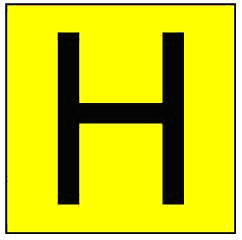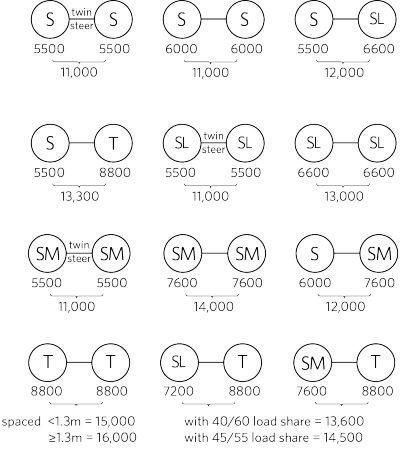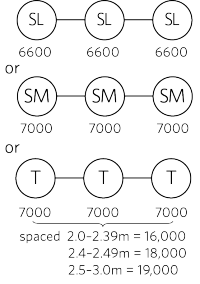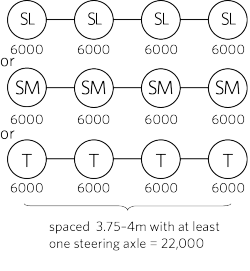The information on this page describes the legal requirements in the Land Transport Rule: Vehicle Dimensions and Mass 2016 that apply to high productivity motor vehicles (HPMVs) operating on a permit.
Land Transport Rule: Vehicle Dimensions and Mass 2016
An HPMV:
exceeds a mass of 44,000kg and/or the maximum length dimensions allowed for standard vehicles, but meets higher individual axle and axle group limits and is no wider or higher than a standard vehicle, and
operates under a route specific HPMV permit issued by a road controlling authority (RCA) on roads and bridges that have been determined to be able to accommodate the additional mass and/or length, and
displays an ‘H’ sign on the front and rear if specified on the permit or if route specific.

There are two main types of HPMV permit: overlength and higher mass.
Higher mass HPMV permits may allow ‘axle weight flexibility’.
This page explains how to apply for an HPMV permit, what these permits cover and what special conditions you and your vehicle must meet. You will likely require several HPMV permits for your vehicle. Waka Kotahi NZ Transport Agency can issue an HPMV permit for longer vehicles to travel at standard legal axle mass. It can also issue HPMV permits for higher axle mass on specific state highways. For higher mass limits on local roads you will need to apply to the relevant RCA, ie the local council, or in Auckland, Auckland Transport.
For longer vehicles, or operation at higher mass on state highways, you will need to complete a High productivity motor vehicle permit application form and send it to a Waka Kotahi office.
If you need information on the dimensional and mass limits for standard motor vehicles, see
There are two types of HPMV permit that may apply to your vehicle. The first is an overlength HPMV permit. This is to allow the vehicle to be longer than a standard vehicle. Approval is provided by Waka Kotahi, and the permit has no expiry date and may include route restrictions.
The second is a route specific higher mass HPMV permit, issued by Waka Kotahi for a set period of time which will be stipulated on the permit. Another application can be made to renew the permit prior to the expiry date.
Waka Kotahi cannot issue permits for local roads unless requested by the local RCA to do so. You will need to approach the local RCA directly for advice. Local RCAs may have their own forms, so you may need to complete additional applications depending on where you propose to travel.
It is possible to design a vehicle combination that does not meet the standard dimension requirements, but still has acceptable performance. For example, the vehicle may have longer overall length to increase deck space, or the truck and trailer may have non-standard lengths within the standard overall length. Any or all of the following dimension requirements can be altered on an HPMV permit, provided that the vehicle meets Waka Kotahi specified performance standards:
An HPMV overlength permit allows the vehicles to exceed length – not width, this is defined in the VDAM Rule under section 5.9(5).
When operating HPMV overlength permitted vehicles be aware of the requirements regarding loading and dimensions defined in Schedule 3 of the VDAM rule, and this will be enforced at roadside.
Schedule 3 of the VDAM rule(external link)
The maximum width that can be operated on an HPMV overlength permit is 2.55m.
Following our communication about non-compliance with HPMV overlength permits, Waka Kotahi, Police and industry representatives have met to find solutions. This will include practical or simulated swept path analysis testing to understand how HPMV combinations move around the road network.
In the interim, we have agreed the following with Police and industry representatives for HPMV combinations exceeding 2.55m in width:
Waka Kotahi has pre-approved some acceptable overlength vehicle designs. If these vehicles are used, you still need to apply for a permit and they will have 'automatic' overlength approval for use on all roads at standard axle mass.
Details of approved pro-forma designs
Higher mass axle and axle group limits are available for overall combination mass greater than 44,000kg. When operating at higher mass limits you must remain on the approved route specified on the HPMV permit.
Below are the higher mass limits that apply to HPMV permits for combination mass over 44,000kg:
Single axle or axle set (one axle or a dual axle of two axles less than 1 metre apart)

Tandem axle set (two axles spaced more than 1 metre but less than 2 metres apart; note that the 2 metres maximum does not apply to twin-steer axle sets)

Tri-axle set (three axles spaced more than 2 metres (or 1.8m in the case of a single standard tyred axle) but less than 3 metres apart

Quad-axle set (four axles spaced not less than 3.75 metres and not more than 4 metres apart)

This chart gives the maximum allowed sum of the mass on any two or more axles that together do not constitute a single tandem axle set, a single tri-axle set or single quad-axle set, where the distance from centre of first axle to centre of last axle is 1.8 metres or more (including maximum gross mass).
| Where the distance from the centre of the first axle to the centre of the last axle is: | Mass (kg) |
| 1.8m but less than 2.0m | 15,500 |
| 2.0m but less than 2.5m | 16,000 |
| 2.5m but less than 3.0m | 17,500 |
| 3.0m but less than 3.3m | 19,000 |
| 3.3m but less than 3.6m | 20,000 |
| 3.6m but less than 4.0m | 21,000 |
| 4.0m but less than 4.4m | 22,000 |
| 4.4m but less than 4.5m | 23,000 |
| 4.5m but less than 4.7m | 23,500 |
| 4.7m but less than 5.0m | 24,000 |
| 5.0m but less than 5.4m | 25,000 |
| 5.4m but less than 5.5m | 26,000 |
| 5.5m but less than 5.8m | 26,500 |
| 5.8m but less than 6.0m | 27,000 |
| 6.0m but less than 6.5m | 28,000 |
| 6.5m but less than 7.0m | 29,500 |
| 7.0m but less than 7.5m | 31,000 |
| 7.5m but less than 8.0m | 32,500 |
| 8.0m but less than 8.5m | 34,000 |
| 8.5m but less than 9.0m | 35,000 |
| 9.0m but less than 9.5m | 36,000 |
| 9.5m but less than 10.0m | 37,000 |
| 10.0m but less than 10.5m | 38,000 |
| 10.5m but less than 11.0m | 39,000 |
| 11.0m but less than 11.5m | 40,000 |
| 11.5m but less than 12.0m | 41,000 |
| 12.0m but less than 12.5m | 42,000 |
| 12.5m but less than 13.0m | 43,000 |
| 13.0m but less than 13.5m | 44,000 |
| 13.5m but less than 14.0m | 45,000 |
| 14.0m but less than 14.5m | 46,000 |
| 14.5m but less than 15.0m | 47,000 |
| 15.0m but less than 15.5m | 48,000 |
| 15.5m but less than 16.0m | 49,000 |
| 16.0m but less than 16.5m | 50,000 |
| 16.5m but less than 17.0m | 51,000 |
| 17.0m but less than 17.5m | 52,000 |
| 17.5m but less than 18.0m | 53,000 |
| 18.0m but less than 18.5m | 54,000 |
| 18.5m but less than 19.0m | 55,000 |
| 19.0m but less than 19.5m | 56,000 |
| 19.5m but less than 20.0m | 57,000 |
| 20.0m but less than 20.5m | 58,000 |
| 20.5m but less than 21.0m | 59,000 |
| 21.0m but less than 21.5m | 60,000 |
| 21.5m but less than 22.0m | 61,000 |
| 22.0m or more | 62,000 or more |
Before an HPMV permit is issued, an overweight route assessment will be carried out by the RCAs covering your proposed routes.
A vehicle operating on an HPMV permit must carry the permit in the truck, and it must be shown to a police officer on request. It is important to comply with all conditions, particularly those relating to mass and route.
Check our current heavy vehicle permit fees
In addition to vehicle requirements in Rules and regulations, such as lighting and glazing, there are some particular requirements that must be met on an HPMV permit. These are:
An HPMV must comply with minimum stability requirements, that is a static roll threshold of 0.35 or greater.
Roll stability control will be required on any trailer fitted with ABS brakes, or on any new build trailers. Older trailers without ABS brakes may be approved with other conditions. This will be explained as part of the permit application process.
An HPMV must only operate on roads specified on the HPMV permit:
The permit will explain the roads you can travel on in more detail.
A vehicle operating on an HPMV permit must not exceed the gross vehicle mass (GVM) or gross combination mass (GCM) as recorded on its certificate of loading (CoL).
A vehicle operating on an HPMV permit must not exceed the lesser of the:
Evidence of this may be asked for as part of the permit application.
Depending on the vehicle design, there may be route restrictions which will be identified on the HPMV permit. The operator of a vehicle over 25 metres long will need to get written permission from the rail service operator if the vehicle is going to travel over a level crossing. It is unlikely, however, that a route with a rail crossing would be approved for vehicles over 25 metres long.
While operating under the terms of the permit, the vehicle must display a retro-reflective ‘H’ sign to the front and rear that complies with AS/NZS 1906.1.2007 – Retro-reflective materials and devices for road traffic control purposes, Part 1: Retro-reflective materials.

If the permit specifies the roads on which the vehicle may operate as a high-productivity motor vehicle then it must display a high-productivity motor vehicle sign.
The RCA that issues an HPMV permit may place additional conditions on the operator if it believes they are necessary to protect the safety of other road users or for the protection of infrastructure. These may include, but are not limited to those listed below:
A vehicle operating on an HPMV permit does not need to meet any travel time restriction, bridge supervision or piloting requirements. For HPMVs, a permit will only be issued if their on-road performance has been accepted to be suitable for the route.